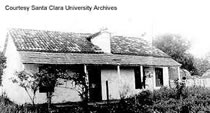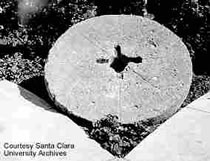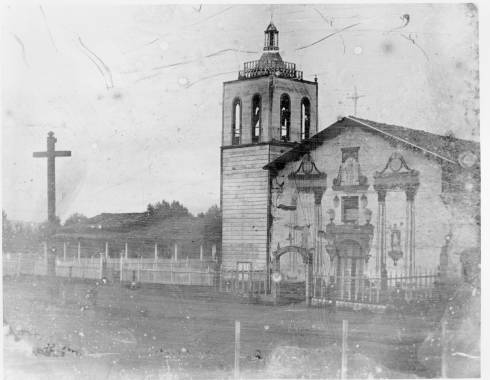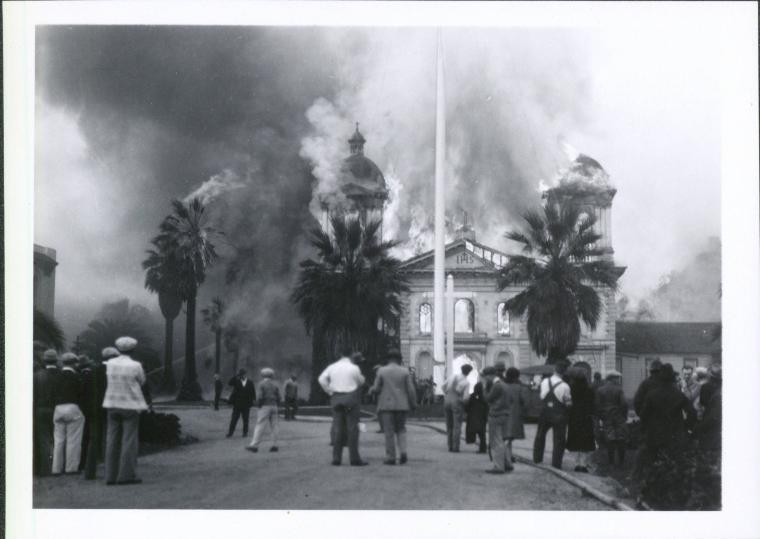
Mission Outbuilding
The first sight that greets visitors to Santa Clara University is the façade of the restored church of Mission Santa Clara de Asís. Santa Clara University, the oldest college in California, is also the only college in the state to be the successor of a Spanish mission. The history of both institutions is intimately bound up with the history of the state. The University, founded in 1851, was born amid the tumultuous growth of the Gold Rush era. The mission, dating back to 1777, was the first outpost of Spanish civilization in the Santa Clara Valley.
Early Exploration of the Santa Clara Valley
European explorers first saw the Santa Clara Valley in 1769, when Gaspar de Portolá’s land expedition to Monterey Bay continued up the coast to San Francisco, then rounded the southern tip of San Francisco Bay. Other early expeditions passed through the valley during the 1770s. The diarists of these expeditions, such as Juan Crespí, Francisco Palóu, Pedro Font, and Juan Bautista de Anza, described the Santa Clara Valley as a broad grassy plain covered with oaks and well-watered with marshy creeks and rivers, whose courses could be traced from a distance by the trees growing along their banks. The explorers commented on the abundant good agricultural land and also on the number of Indian settlements. All agreed that the Santa Clara Valley (known at this time as the Llano de Los Robles, or Plain of the Oaks) was an excellent place for a mission.
One of these expeditions, in 1774, was specially ordered by the Spanish Viceroy Antonio Bucareli to select sites for future missions. The leaders of the expedition, Governor Fernando de Rivera y Moncada and Fray Francisco Palóu, thought that an ideal site would be on San Francisquito Creek near the Palo Alto redwood tree. It seemed to be the perfect location: good land, sources of water and firewood, access to the Bay, and many Indian villages nearby. However, when de Anza and Font revisited the site two years later, they decided the place would not be suitable after all, because the San Francisquito Creek dried up in the summer. Instead, they recommended a site to the southeast, on a river that they named Nuestra Señora de Guadalupe (Our Lady of Guadalupe).
Viceroy Bucareli had called for the exploration and occupation of the San Francisco Bay region in 1773 in order to strengthen New Spain’s northern frontier and secure the valuable port of San Francisco against Russian or British expansion. Part of his plan was to establish two missions, one at the mouth of the harbor and the other at its southern end. By September of 1776, the northern mission, San Francisco de Asís (Mission Dolores) had been founded, but its southern companion, to be named for St. Francis’ childhood friend, St. Clare of Assisi, had not. Consequently, in November 1776, Governor Rivera set out from Monterey with Fray Tomás de la Peña to make one more survey of the area. They selected a site on the banks of the Guadalupe, then journeyed to San Francisco so that Rivera could visit the Presidio there.
The Mission’s Humble Beginnings
On Nov. 30, Rivera returned to Monterey in order to dispatch Fray de la Peña’s partner, Fray José Murguía, with soldiers and supplies for the new mission. The soldiers arrived in San Francisco at the end of December, and on Jan. 6, 1777, Fray de la Peña, the soldiers, and the lieutenant commander of the Presidio started the journey down the peninsula. On the banks of the Guadalupe River, they set up a cross and constructed a makeshift altar under a tree. On Jan. 12, 1777, Fray de la Peña said the first Mass at the new Mission Santa Clara de Asís, the eighth mission to be founded in California.

Photo of mill stone taken before May 22, 1934.
A few days later, Fray Murguía arrived from Monterey with the supplies, including religious articles gathered from the missions in Baja California and designated for a future Mission Santa Clara as long before as 1768. With the supplies at hand, Fathers Murguía and de la Peña were now able to begin the work of converting the Indians.
The Indians they wished to convert, known as Costanoans (from the Spanish Costeños, or people of the coast) or Ohlones (an Indian word of uncertain meaning), had lived in the hills and valleys around the Bay for thousands of years before the arrival of the Spanish. Unlike the Indians of Mexico, the Ohlones built no great cities, nor did they develop agriculture. They lived in tiny settlements, called by the Spanish rancherías, and survived by hunting and gathering. Although their staple food was the acorn, ground by the women in stone mortars and made into porridge or cakes, they varied their diet with fish and shellfish from the Bay and rivers, with seeds and roots from the meadows, and with venison, rabbit, and quail. The Ohlones lived a peaceful life in harmony with their environment, a life that changed irrevocably with the coming of the Franciscan missionaries.
The two missionaries assigned to Santa Clara worked diligently at the task of converting the Indians, who inhabited more than 40 rancherías in the vicinity. They also tackled the immediate problem of building places for themselves and for the slowly growing number of converts to live, work, and worship. By the end of 1777, the padres and their assistants had completed the church and the priests’ residence; another house was under construction. All the buildings were of upright logs with dirt roofs. They also built two corrals, one for cattle and one for sheep and goats, and a wooden bridge across the Guadalupe. Grain fields, watered by irrigation ditches, had been planted.
Guadalupe River Overflows
This promising beginning, however, was wiped out in January 1779 when the Guadalupe River overflowed its banks. Although they valued the river as a water source, Peña and Murguía realized that the flood danger made the mission’s location inadvisable. Salvaging everything they could, they moved to an interim site on higher ground to the south. Here they began again, setting up new log buildings and digging new irrigation ditches. Fray Juñipero Serra blessed the second, temporary, church on Nov. 11, 1779. Meantime, Peña and Murguía searched for a permanent location for Mission Santa Clara.
By 1781 they had found it: far enough away from the river to be safe from floods, but close enough to allow an irrigation canal to bring water to the fields. On Nov. 19, 1781, in an elaborate ritual, Father Serra blessed and laid a cornerstone for the third Mission Church. In a cavity in the cornerstone were placed a crucifix, religious images, and Spanish coins to signify the Church treasury. (The cornerstone was accidentally found by a workman digging for a gas main along Franklin Street in 1911. The cornerstone and its contents are on display in the Mission Room of the University’s de Saisset Museum.)
The New Church

Earliest known daguerrotype photograph of the Mission in 1854. Bell tower is sheathed with planks. Facade is painted with images of St. Clare, Francis and John the Baptist.
After the cornerstone ceremony, work began on the new church. It was completed 2 1/2 years later, in May 1784. Unlike the two previous temporary churches, which were built of wood, the permanent church was an imposing adobe structure 100 feet long, 22 feet wide and 20 feet high. The four-foot-thick adobe walls were whitewashed inside and out and decorated with a painted border on the interior. Unfortunately, Fray Murguía, who had designed the church, died four days before the dedication ceremony, which was held May 15, 1784. Father Serra was the celebrant at the ceremony, assisted by Fathers Peña and Palóu. Also in attendance were Governor Pedro Fages, the entire mission community, and the inhabitants of the Pueblo of San José (which had been founded in November 1777). The ceremony was not entirely solemn; Fray de la Peña reported that "the celebration was carried on amid the ringing of bells, salutes from the muskets of the soldiers and with the fireworks on the Mission." The following day, Sunday, May 16, Serra celebrated the first Mass in the new church.
Of course, the missionaries of Santa Clara did not spend all their time fleeing floodwaters and building churches. They remained at the third site for 34 years, during which time they could concentrate on their main functions, which were both spiritual and material. The Franciscans were dedicated missionaries driven by their desire to bring salvation to the Indians. They were also administrators of the Spanish government’s colonial policy. A Spanish frontier colony such as California typically had three institutions: the pueblo, the presidio, and the mission. Pueblos were civil settlements; presidios provided military protection; missions were responsible for the native population.
At the missions, the Indians learned the rudiments of Christianity and received the sacraments of the Church. Mission Santa Clara, incidentally, performed more baptisms than did any other mission. The Indians also learned Spanish, because of the bewildering number of distinct Indian languages spoken in California. In addition, the friars tried to teach the Indians the skills necessary to become productive Spanish citizens. While the Indian women learned to cook and make clothing, the men farmed wheat, corn, and beans and herded cattle and sheep on the missions’ extensive lands. In 1827, Mission Santa Clara owned 14,500 head of cattle and 15,500 head of sheep. The produce of the mission helped to supply the neighboring pueblo and presidio in addition to the mission community itself. The mission was prosperous. Unfortunately, at Santa Clara as at all the California missions, the Indians had no resistance to diseases like measles and smallpox, which the Spanish carried with them. Santa Clara led the other missions in burials as well at baptisms.
The Earthquake and Secularization
After a long period of calm, the quiet at Mission Santa Clara was broken in 1818, when the Mission Church suffered severe damage in an earthquake. Fray José Viader and Fray Magín Catalá, who served at Santa Clara from the 1790s to the1830s, built a temporary adobe church near the present site of Kenna Hall on the University campus. This building was used as the church between 1819 and 1825 and as the Indian boys’ residence between 1825 and 1836. After secularization, the building eventually became a dance hall; it was purchased by the college in 1860 and razed in 1867.
Construction of a new permanent mission compound at the fifth and final site began in 1822. The church, residences, workshops, and storerooms were laid out in a large quadrangle. (The only remaining structures from this period are now known as the Adobe Lodge, which houses the University’s Faculty Club, and the Adobe Wall. They formed the southwest corner of the square.) The new church was dedicated Aug. 11, 1825. This building, with various modifications, stood until 1926.
Life at Mission Santa Clara’s fifth location continued much as it had for the previous 44 years. However, events in the outside world would soon change the mission’s time-honored routines. After Mexico gained its independence from Spain in 1822, voices clamoring for the secularization of the missions acquired a sympathetic hearing. To secularize meant to turn over a mission from the missionary order that founded it to the secular, or diocesan, clergy, and to distribute the mission lands to the Indians. Ideally, in the Spanish mission system, secularization was implemented after a mission had been in existence for 10 years. In California, however, secularization was delayed because the missionaries felt the Indians were not yet ready for life outside the regimentation of the mission.
Nevertheless, beginning in the 1820s, more and more lay people called for the immediate secularization of the California missions. Their motives were mixed. Some liberal Mexican revolutionaries thought the Church a reactionary institution and wanted its extensive powers and privileges curtailed. The motives of the lay population of California were less ideologically inspired—they simply wanted the missions’ lands. The combination of idealism and greed was unstoppable, and secularization began in 1834. Mission Santa Clara was secularized Dec. 27, 1836.
The secularization law provided that half the mission property be distributed among the Indians and half controlled by a lay administrator. Because there were so few secular priests in California, the Franciscans stayed on at the missions as parish priests and were allowed to retain the buildings in the mission quadrangles. Secularization did not, however, go according to plan. The Indians were quickly defrauded of their lands and livestock. At Santa Clara, American squatters lived on mission property. All over California, mission buildings fell into disrepair and the Indians were exploited worse than they had been under the mission system.
Santa Clara College

Santa Clara College, founded in 1851
Mission Santa Clara operated as a parish during the 1830s and 1840s, charged with serving the religious needs of the town of San José. However, its Franciscan pastors during this period were not very conscientious. In fact, the behavior of the mission’s last Franciscan, José Suárez del Real, gave cause for scandal. With the coming of the Gold Rush in 1849, San José’s population grew rapidly. There was now even greater need for both religious and educational institutions in the Santa Clara Valley, needs Mission Santa Clara seemed unable to supply. In December of 1850, however, the new bishop of California, the Dominican Joseph Sadoc Alemany, recognizing the need for more schools and churches, offered the decrepit buildings of Mission Santa Clara to John Nobili, S.J., who had been in California since 1849 attempting to open a school. On March 4, 1851, Bishop Alemany appointed Nobili pastor of Mission Santa Clara. Nobili took possession on March 19; he and Suárez del Real, who was being sent back to Mexico, signed the inventory of mission property on March 21. In May, after only a few weeks of preparations, Santa Clara College, the first in the State of California, began instructing students.
Santa Clara College struggled during the first few years of its existence, troubled by a shortage of both teachers and money, by primitive facilities, and by legal difficulties involving the claim to the mission property. In 1861, however, a new and energetic president, Burchard Villiger, S.J., began a four-year presidency that would transform Santa Clara. Part of his program was to remodel the College’s ugly adobe buildings, including the Mission Church. Workmen attached a new wooden façade with two bell towers over the old adobe front of the building. In 1885, another president, Robert Kenna, S.J., remodeled the church again, leaving the façade intact but widening the interior to increase the seating capacity.

Fire in Mission Church - October 25, 1926
The final "remodeling" of the fifth Mission Church occurred on Oct. 24, 1926, when faulty wiring set off a fire in the church’s north bell tower. A priest saying morning Mass gave the alarm, and students and faculty tried valiantly to save the historic old building. The church, sadly, was totally destroyed, although students did manage to rescue many statues and paintings, other liturgical objects, and one of the mission bells, which rang the De Profundis for the dead that night, as it had for a hundred years.
Encouraged by a flood of sympathy and donations, the University administration began reconstruction of the destroyed church almost immediately. Rather than a duplication of the church that had burned, the restoration attempted to recapture the appearance of the 1825 church before its many remodelings. The church was again made wider than the original because it had to serve as the University chapel. The façade, however, returned to its original one-tower design, although it was eventually embellished with carved wooden statues of the saints instead of painted decorations. The decorations of the interior also followed the original lines, except that the patterns on the walls were painted in pastel pink and blue instead of the original brilliant red and yellow. Careful copies were made of the destroyed Mexican reredos and Dávila’s painted ceiling. The restoration, one of the earliest undertaken, is imperfect, but it imparts much more of the flavor of the original than did the building it replaced. The sixth Mission Church was dedicated May 13, 1928. From then until now it has served as the University chapel, used by the University community for Masses, baptisms, weddings and funerals. The Mission Church is open to the public and welcomes visitors.
For further reading:
Engelhardt, Zephyrin. The Holy Man of Santa Clara: Life, Virtues and Miracles of Fr. Magín Catalá, O.F.M. (San Francisco: J.H. Barry, 1909).
Garr, Daniel. "Power and Priorities: Church-State Boundary Disputes in Spanish California." California History 57 (1978), 364-75.
Krell, Dorothy, ed. The California Missions: A Pictorial History (Menlo Park: Lane Publishing Co., 1979).
McKevitt, Gerald, S.J. The University of Santa Clara: A History, 1851-1977 (Stanford: Stanford University Press, 1979).
Margolin, Malcolm. The Ohlone Way: Indian Life in the San Francisco-Monterey Bay Area (Berkeley: Heyday Books, 1978).
Spearman, Arthur, S.J. The Five Franciscan Churches of Mission Santa Clara, 1777-1825 (Palo Alto: National Press, 1963).
Webb, Edith. Indian Life at the Old Missions (Los Angeles: W.F. Lewis, 1952).
By Teresa Pugh